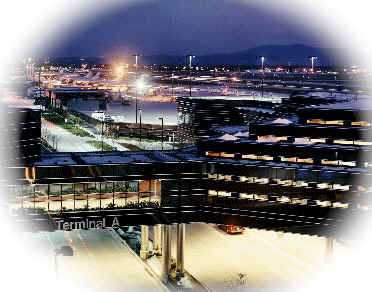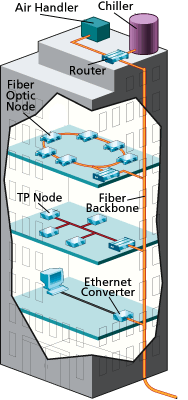Until recently, however, many buildings, owners and systems integrators have resisted fiber optic technology. |
Raytheon Control-By-Light is based in Sudbury, MA. |
AutomatedBuildings.com
|
[an error occurred while processing this directive] |
Until recently, however, many buildings, owners and systems integrators have resisted fiber optic technology. |
Raytheon Control-By-Light is based in Sudbury, MA. |
Hidden from view beneath structural steel and concrete, the central nervous system of any modern building relies on miles of wire and cable to control lighting, heating, air conditioning, ventilation and other automated functions. This electronic network can also carry security, access and fire alarm messages and is critical to building operations and the comfort and safety of the people inside. Failure of even the smallest section can disrupt an entire operation, or worse.
At the start of the 21st Century, developers, owners, architects and engineers increasingly are choosing fiber optics over more traditional technology to ensure the reliability and safety of these "smart building" systems. Fiber transmits data digitally in the form of light, not electricity. This is the source of fiber's great strengths - speed, data integrity, high bandwidth, security and reliability - that make it the medium of the millennium for building automation, fire alarm, access control and security systems.
 Since you are reading this on line, chances are
you already know the benefits of high bandwidth fiber optic networks. Fiber
has revolutionized the telecommunications industry through its ability to
carry virtually unlimited amounts of data at high speeds - up to 200 times as
fast as copper wire. This same capacity makes fiber the ideal medium for
high-rise buildings and campuses that need high-throughput backbones to
communicate sensor data and control signals reliably between multiple floors
and buildings.
Since you are reading this on line, chances are
you already know the benefits of high bandwidth fiber optic networks. Fiber
has revolutionized the telecommunications industry through its ability to
carry virtually unlimited amounts of data at high speeds - up to 200 times as
fast as copper wire. This same capacity makes fiber the ideal medium for
high-rise buildings and campuses that need high-throughput backbones to
communicate sensor data and control signals reliably between multiple floors
and buildings.
Fiber also has the advantage over copper or twisted pair when it comes to security and reliability. Fiber optic lines are 100% tamper-proof and impervious to electromagnetic interference, lightning, wind, moisture, salt or chemical corrosion, high voltages and electrical short-circuiting. This ensures clear, reliable communication in harsh environments, whether the lines are installed outside, between buildings in a chemical refinery, or inside a conduit with electric power cables. Plus with fiber, modern transceivers are available that constantly measure the amount of received optical energy, and can warn of attempts to tamper with the network.
Until recently, however, many buildings, owners and systems integrators have resisted fiber optic technology. Despite its obvious benefits, fiber has suffered from a reputation as a difficult and costly medium, too tricky for most contractors to handle. That has changed, with a new generation of "plug and play" components based on Echelon LonWorks interoperable standards. Now fiber can be less expensive and easier to install and use than twisted pair. And fiber-based solutions are becoming increasingly available as fiber optic data paths become more available. Fiber optic technology grew slowly after its introduction in 1976, according to industry figures, but in the last six years the amount of fiber deployed worldwide has nearly quadrupled, to more than 100 million miles. The greater access to fiber can only mean lower costs in the future for applications from telephone, television and data transmission to evolving projects like backbones for building, company or campus networks.
[an error occurred while processing this directive]The future of fiber optic LonWorks solutions for building automation, energy efficiency and high-level security systems is already on display in North America and Europe. Raytheon Control-By-Light, a part of the Commercial Electronics division of Raytheon Company, has played a key role in recent projects taking advantage of fiber's strengths. Here are a few examples:
 Ring redundancy is a key element at many of the
projects using Raytheon Control-By-Light components - not just for security
but to enhance the system's adaptability and expandability. The Raytheon
technology allows for "hot-swapping" of devices or nodes on the
network with no loss of function on the network. It's another feature that
makes a building "future-proof" - able to integrate new technology
seamlessly. Raytheon's bidirectional fiber also offers a pure LonWorks
solution that is simple and more cost-effective than Ethernet connections for
communicating between floors and systems, especially in large buildings and
high-rises. Because Ethernet links LonWorks subsystems using traditional
twisted pair interconnects, it is subject to the limitations and vulnerability
of copper wire. And Ethernet requires building functions to rely on the
building's information technology infrastructure. If the server goes down, the
entire building shuts down.
Ring redundancy is a key element at many of the
projects using Raytheon Control-By-Light components - not just for security
but to enhance the system's adaptability and expandability. The Raytheon
technology allows for "hot-swapping" of devices or nodes on the
network with no loss of function on the network. It's another feature that
makes a building "future-proof" - able to integrate new technology
seamlessly. Raytheon's bidirectional fiber also offers a pure LonWorks
solution that is simple and more cost-effective than Ethernet connections for
communicating between floors and systems, especially in large buildings and
high-rises. Because Ethernet links LonWorks subsystems using traditional
twisted pair interconnects, it is subject to the limitations and vulnerability
of copper wire. And Ethernet requires building functions to rely on the
building's information technology infrastructure. If the server goes down, the
entire building shuts down.
![]() Control-By-Light solutions can be mixed and
matched with non-fiber links and subnets. They connect fiber to fiber and
fiber to twisted pair to ensure the best medium for the job - anywhere in the
network. But when the backbone of a building automation system is fiber optic,
the system is capable of handling heavy traffic, over longer distances without
repeaters, and it is not affected by power spikes or failure, system overload
and even interference from lightning, heavy winds which can bottleneck or cut
the flow of communication.
Control-By-Light solutions can be mixed and
matched with non-fiber links and subnets. They connect fiber to fiber and
fiber to twisted pair to ensure the best medium for the job - anywhere in the
network. But when the backbone of a building automation system is fiber optic,
the system is capable of handling heavy traffic, over longer distances without
repeaters, and it is not affected by power spikes or failure, system overload
and even interference from lightning, heavy winds which can bottleneck or cut
the flow of communication.
Fiber optics became the medium of choice for the telecommunications industry because it is an efficient, high-bandwidth medium that carries greater amounts of information faster, more reliably and for longer distances than any other communications medium. Now, "plug and play" routers, transceivers and other products have enhanced its affordability and ease of use. These open standard, off-the-shelf fiber optic components are lowering the costs of installation and operation, establishing fiber optics as the ideal medium for automated building control systems in the 21st Century.
Brian D. Morrison is director of Raytheon Control-By-Light, a part of the Commercial Electronics division of Raytheon Company. Raytheon Control-By-Light is based in Sudbury, MA. Additional information about this company can be found at www.control-by-light.com.
[an error occurred while processing this directive]
[Click Banner To Learn More]
[Home Page] [The Automator] [About] [Subscribe ] [Contact Us]